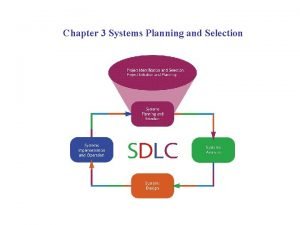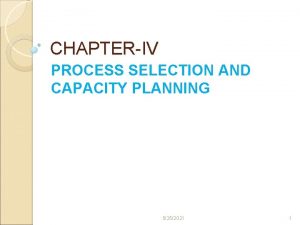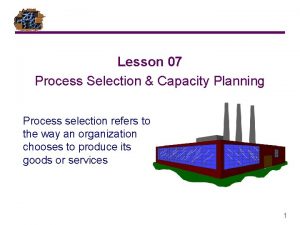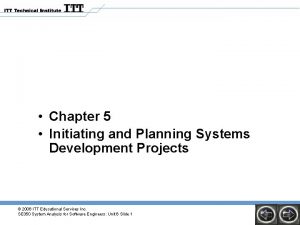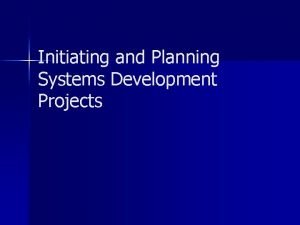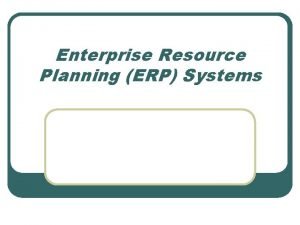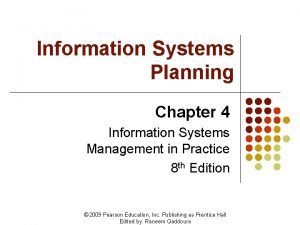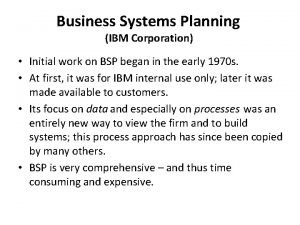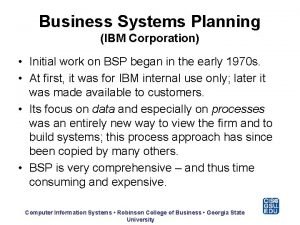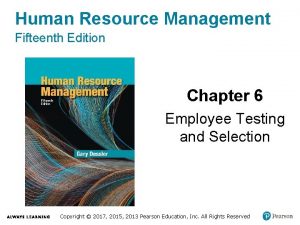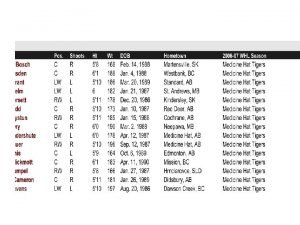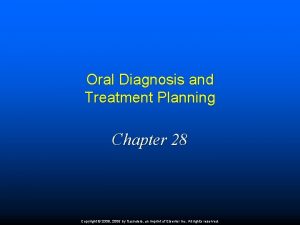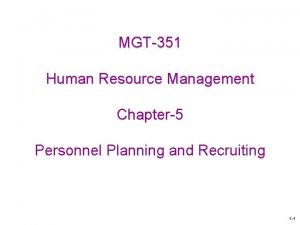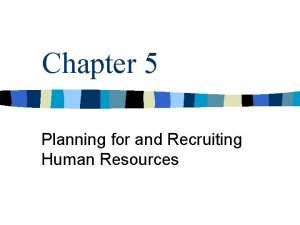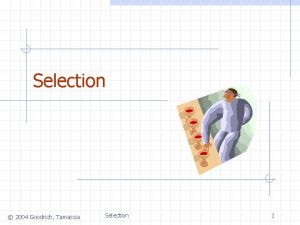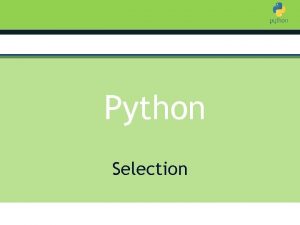Chapter 3 Systems Planning and Selection Chapter 3





















































- Slides: 53

Chapter 3 Systems Planning and Selection

Chapter 3 Systems Planning and Selection • Organizations must set priorities and a direction for systems development that will yield development projects with the greatest net benefits. • The reason for any new or improved information system is to add value to the organization. • Business value comes from supporting the most critical business goals and helping the organization deliver on its business strategy.


Chapter 3 Systems Planning and Selection • Three key sources for information systems projects Replace or extend and existing system in order to gain needed information or to provide a new service to customer Improve an existing system in order to help organization meet its operate objects Make a system more efficient, less costly to operate, or want to move a system to a new operating environment

Chapter 3 Systems Planning and Selection • Identification Potential Development Projects 高階主管 (Top manager) Greater strategic focus Largest project size Longest project duration 指導委員會 (Steering committee) Cross-functional focus Greater organizational change Formal cost-benefit analysis Larger and riskier projects Top Down

Chapter 3 Systems Planning and Selection • Identification Potential Development Projects 使用者部門 Narrow, tactical focus Faster development Fewer users, management layers, and business functions 系統發展團隊 Integration with existing systems focus Fewer development delays Less concern on cost-benefit analysis Bottom Up

Chapter 3 Systems Planning and Selection • Classification and Ranking IS Development Projects 評估準則 1. Value Chain Analysis (價值鏈分析) – Porter, 1985 Analyzing an organization’s activities to determine where value is added to products and/or services and the costs incurred for doing so; usually also includes a comparison with the activities , added value, and costs of other organizations for the purpose of making improvements in the organization’s operations and performance.

Chapter 3 Systems Planning and Selection • Organizational Value Chain

Chapter 3 Systems Planning and Selection 2. Strategic Alignment Extend to which the project is viewed as helping the organization achieve its strategic objectives and long-term goals 3. Potential Benefits Extends to which the projects is viewed as improving profits, customer services, etc. and the duration of these benefits 4. Resource Availability Amount and type of resources the project requires and their availability

Chapter 3 Systems Planning and Selection 5. Project Size/Duration Number of individuals and the length of time needed to complete the project 6. Technical Difficulty/Risks Level of technical difficulty to successfully complete the project within given time and resource constraints

Chapter 3 Systems Planning and Selection • Corporate Strategic Planning (具體的策略規劃) -An ongoing process that defines the mission, objectives, and strategies of an organization Step 1 Step 2 Step 3 Current Future Enterprise Strategy Plan Enterprise

Chapter 3 Systems Planning and Selection • Misson Statement – A statement that makes it clear what business a company is in (希望是怎麼樣的公司) • Objective Statements – A series of statements that express an organization’s qualitative and quantitative goals for reaching a desired future position (broad and timeless, 不需要太精確) • Competitive Strategy – The method by which an organization attempts to achieve its mission and Michael Porter objectives 1980 (Rolls Royce and GEO)

Chapter 3 Systems Planning and Selection • Selecting IS Development Projects

Chapter 3 Systems Planning and Selection • Deliverables and Outcomes for the First SDLC Phase Incremental Commitment reassess Working System n. Incremental commitment: Continuous reassessment of project after each phase

Chapter 3 Systems Planning and Selection • Information Systems Planning (ISP) An orderly means of assessing the information needs of an organization and defining the systems, databases, and technologies that will best satisfy those needs

Chapter 3 Systems Planning and Selection • Information Systems Planning (ISP)

Chapter 3 Systems Planning and Selection

Chapter 3 Systems Planning and Selection • Describing the Current Situation - 評估現有資訊系統 Human Resource (人力資源) Data Process Technologies

Chapter 3 Systems Planning and Selection • Describing the Current Situation - 評估現有資訊系統 Selecting a Planning Team Review corporate documents Interview managers executives customers Represent current situation Reviews of competitors, markets products, and finance • Organization Locations • Units (a list of people, business) • Functions • Processes • Data • Information System

Chapter 3 Systems Planning and Selection Functions - Cross-organization locations of activities used to perform day-to-day business operations. Ex: R&D, Purchasing, Sales, Manufacturing Processes - A list of manual or automated procedures designed to support business functions. Ex: payroll processing, product shipping Data Entities - A list of the information items generated, updated, deleted, or used within business processes. Information Systems - Automated and non-automated systems used to transform data into information to support business processes.

Chapter 3 Systems Planning and Selection • Describing the Current Situation - 評估現有資訊系統 • Organization Locations • Units (a list of people, business) • Functions • Processes • Data • Information System List Data List X Function List Upper CASE • Matrix Construction • Matrix Analysis Matrix X

Chapter 3 Systems Planning and Selection • Describing the Target Situation, Trends, and Constraints blueprints -- an Information architecture Edit initial list and record the desired locations, units, functions, processes, data, and information systems within the constraints and trends of the organization environment Update matrices

Chapter 3 Systems Planning and Selection • Initiating and Planning Systems Development Projects Deliverables and Outcomes Baseline Project Plan (BPP) - internal document 描述專案範圍(Scope), 專案執行完成可帶來的收益(benefit), 專案執行所需花費的成本(Cost),專案執行的風險(Risk)和資 源(Resource)的需求 - 可用於 project selection committee Statement of Work (SOW) - Outlines objectives and constraints of the project to the customer 給客戶的文件,內容包含專案的產出為何,並描述專案要完成 所需的各種 作

Chapter 3 Systems Planning and Selection • Initiating and Planning Systems Development Projects How much effort should the expended on the project initiation and planning process? (需花費多少的努力在此步驟) 總投入的10%~20% (時間與成本的花費將在未來回收 - Project Scope 和 feasibility analysis) Who is responsible for performing the project initiation and planning process? (誰負責執行) 有經驗的系統分析師,或系統分析師團隊 Why is project initiation and planning such a challenging activity? (為什麼此一步驟是具挑戰性的活動) Vague system request document Tangible Project Description 讓所有部門均同意一個Project的方向是很困難的


Chapter 3 Systems Planning and Selection • Project Planning Project planning is the process of defining clear, discrete activities and work needed to complete each activity within a single project. Baseline Project Planning Process Statement of Work • Describing the project scope, alternatives, and feasibility • Dividing the project into manageable tasks • Estimating resources and creating a resource plan • Developing a preliminary schedule. . .

Chapter 3 Systems Planning and Selection • Project Feasibility Economic, Technical, Operational, Schedule, Legal &Contractual, Political 限制條件 Time Resource Project 每個Project的限制因素與其重要性並不一定相同

Chapter 3 Systems Planning and Selection • Economic Feasibility - A process of identifying the financial benefits and costs associated with a development project Determining Project Benefits • Tangible Benefit A benefit derived from the creation of an information system that can be measured in dollars and with certainty • Intangible Benefit A benefit derived from the creation of an information system that cannot be easily measured in dollars or with certainty

Chapter 3 Systems Planning and Selection Examples • Cost reduction and avoidance • Error reduction • Increased flexibility • Increased speed of activity • Improvement of management planning and control • Opening new markets and increasing sales opportunities • Increased employee morale • Competitive necessity • More timely information • Promotion of organizational learning and understanding

Chapter 3 Systems Planning and Selection

Chapter 3 Systems Planning and Selection • Determine Project Cost Tangible cost: A cost associated with an information system that can be measured in terms of dollars and with certainty Intangible cost: A cost associated with an information system that cannot be easily measured in terms of dollars or with certainty One-time cost: A cost associated with project start-up and development , or system start-up Recurring cost: A cost resulting from the ongoing evolution and use of a system Fixed costs and Variable costs

Chapter 3 Systems Planning and Selection

Chapter 3 Systems Planning and Selection

Chapter 3 Systems Planning and Selection The Time Value of Money

Chapter 3 Systems Planning and Selection • The Time Value of Money (TVM) 錢是有時間價值的 - Cost of Capital Y dollars n years from now i : Discount Rate NPV (Net present value) : PV 的累計

Chapter 3 Systems Planning and Selection Break-Even Analysis

Chapter 3 Systems Planning and Selection General NPV cash flow Break-Even Ratio One unit time Yearly NPV cash flow

Chapter 3 Systems Planning and Selection • Operational Feasibility – Assessment of how a proposed system solves business problems or takes advantage of opportunities • Technical Feasibility • Assessment of the development organization’s ability to construct a proposed system

Chapter 3 Systems Planning and Selection • Schedule Feasibility – Assessment of timeframe and project completion dates with respect to organization constraints for affecting change • Legal and Contractual Feasibility – Assessment of legal and contractual ramifications of new system Ex: Copyright, antitrust legislation, financial reporting standards, license agreement for using hardware and software, … *若公司過去使用其他供應商的系統或服務,而目前想自行控制此 系統時此因素更應加以考量

Chapter 3 Systems Planning and Selection • Political Feasibility – Assessment of view of key stakeholders in organization toward proposed system

Chapter 3 Systems Planning and Selection Building the Baseline Project Plan • Objectives – Assures that customer and development group have a complete understanding of the proposed system and requirements – Provides sponsoring organization with a clear idea of scope, benefits and duration of project.

Chapter 3 Systems Planning and Selection Building the Baseline Project Plan 1. Introduction 2. System Description 3. Feasibility Assessment 4. Management Issues

Chapter 3 Systems Planning and Selection Building the Baseline Project Plan textual or diagram - Introduction Project Overview – project scope, feasibility, justification, resource requirement, and schedule, problem, environment, constraint determining factors of scope • 公司中有那些單位會受到影響 • 目前有那些系統會被影響 • 有那些公司的內部人員或其他人員會受到影響 • 新開發系統的功能為何 Recommendation

Chapter 3 Systems Planning and Selection Building the Baseline Project Plan - System Description Alternatives – very high-level, most narrative in form Ex: Mainframe with central database , … System Description – provides a description of the selected configuration and a narrative of input information, tasks performed, and resultant information

Chapter 3 Systems Planning and Selection Building the Baseline Project Plan - Feasibility Assessment • Economic Analysis • Technical Analysis • Operational Analysis • Legal and Contractual Analysis Human Resource • Political Analysis • Schedules, Timeline, and Resource Analysis PERT Resource Schedule

Chapter 3 Systems Planning and Selection Building the Baseline Project Plan - Management Issue • Team Configuration and Management Idea分享 Progress 確認 • Communication Plan – team members 之間及user 與發展團隊之間 • Project Standards and Procedure – Procedures for submitting and approving the project change. How deliverables will be evaluated and accepted by the customer. • Other Project-Specific Topics

Chapter 3 Systems Planning and Selection • Reviewing the Baseline Project Plan A peer group review of any product created during the systems development process Workthrough Project Approval Body 並不一定是 Formal的過程

Chapter 3 Systems Planning and Selection • Walkthrough – Peer group review – Participants • Coordinator • Presenter • User • Secretary • Standards Bearer • Maintenance Oracle – Activities • Walkthrough review form • Individuals polled • Walkthrough action list – Advantages • Assures that review occurs during project

Chapter 3 Systems Planning and Selection

Chapter 3 Systems Planning and Selection

Chapter 3 Systems Planning and Selection Internet Development • Development process for Internet projects is no different than other projects • Special issues need to be taken into account • Electronic Commerce (EC) – Internet based communication designed to support business activities

Chapter 3 Systems Planning and Selection • Internet – Worldwide network of networks used for electronic commerce • Intranet – Internet-based communication to support business activities within a single organization • Extranet – Internet-based communication to support business-to-business activities

Chapter 3 Systems Planning and Selection • Electronic Data Interchange (EDI) – The use of telecommunications technologies to transfer business documents directly between organizations • Internet vs. Intranet/Extranet Apps – Intranet/Extranet – Developer knows how application will be run and used – Internet – Developer faces various unknowns
 System planning example
System planning example Two way selection and multiway selection in c
Two way selection and multiway selection in c Multiway selection in c
Multiway selection in c Procedure of pure line selection
Procedure of pure line selection Balancing selection vs stabilizing selection
Balancing selection vs stabilizing selection Artificial selection vs natural selection
Artificial selection vs natural selection K selected
K selected Natural selection vs artificial selection
Natural selection vs artificial selection Artificial selection vs natural selection
Artificial selection vs natural selection 5 points of natural selection
5 points of natural selection What is exponential growth in ecology
What is exponential growth in ecology Natural selection vs artificial selection
Natural selection vs artificial selection Process selection and capacity planning
Process selection and capacity planning Media planning and selection
Media planning and selection Process selection and capacity planning
Process selection and capacity planning N planning
N planning Long medium and short term planning in primary schools
Long medium and short term planning in primary schools Language policy in pakistan slideshare
Language policy in pakistan slideshare Initiating and planning systems development projects
Initiating and planning systems development projects Initiating and planning systems development projects
Initiating and planning systems development projects Decision support systems and intelligent systems
Decision support systems and intelligent systems Strategic planning vs tactical planning
Strategic planning vs tactical planning Goal achievement matrix
Goal achievement matrix Role segmentation workforce planning
Role segmentation workforce planning Perencanaan agregat
Perencanaan agregat Aggregate planning is capacity planning for
Aggregate planning is capacity planning for Aggregate planning is capacity planning for
Aggregate planning is capacity planning for Application of enterprise resource planning
Application of enterprise resource planning Information systems planning
Information systems planning Business system planning
Business system planning Business systems planning (bsp)
Business systems planning (bsp) Principles of complex systems for systems engineering
Principles of complex systems for systems engineering Embedded systems vs cyber physical systems
Embedded systems vs cyber physical systems Elegant systems
Elegant systems Chapter 6 employee testing and selection ppt
Chapter 6 employee testing and selection ppt Process selection and facility layout
Process selection and facility layout Product vs process layout
Product vs process layout Define offal
Define offal Chapter 24 the immune and lymphatic systems and cancer
Chapter 24 the immune and lymphatic systems and cancer Lymph diagram
Lymph diagram Recruitment selection and induction policies and procedures
Recruitment selection and induction policies and procedures Research approach
Research approach Chapter 15 section 1 darwins theory of natural selection
Chapter 15 section 1 darwins theory of natural selection Chapter 8 the international market selection process
Chapter 8 the international market selection process The selection chapter 18
The selection chapter 18 Chapter selection
Chapter selection Vigil honor petition
Vigil honor petition Project selection and portfolio management
Project selection and portfolio management Chapter selection
Chapter selection Chapter 28 oral diagnosis and treatment planning
Chapter 28 oral diagnosis and treatment planning Forecasting the supply of outside candidates
Forecasting the supply of outside candidates Chapter 9 career planning and development
Chapter 9 career planning and development Chapter 5 planning for and recruiting human resources
Chapter 5 planning for and recruiting human resources Management chapter 5 planning and decision making
Management chapter 5 planning and decision making
